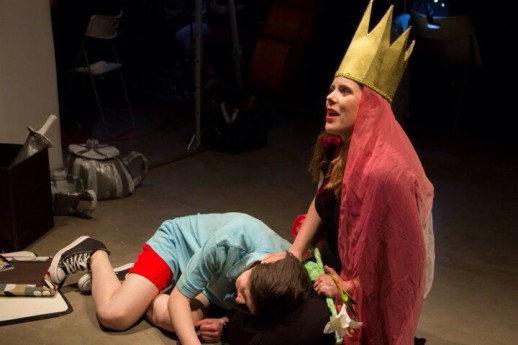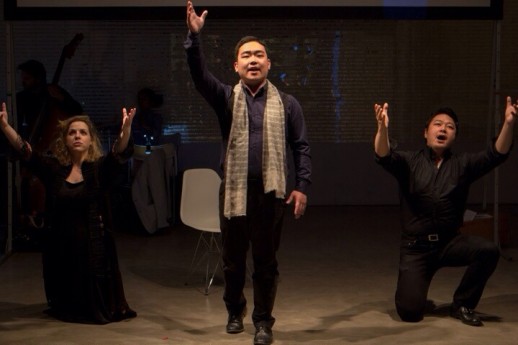
These are principles I heartily approve, but since my recent operatic experience has included a thrilling Orlando in an art gallery in the Bowery and a wonderfully theatrical Lucrezia Borgia in Bushwick, the local opera scene Bare Opera enters is not, perhaps, such a desert. It’s getting hard to see the mirage for all the oases.
That said, Bare Opera’s initial program is very promising: intriguing scores (one unusual, one familiar), sturdy young singers, an appeal to technological innovation not involving that Devil’s Instrument the microphone, and a very tight little orchestra superbly led by Sesto Quatrini.
My chief cavil with the event was its locale. The Robert Miller Gallery consists of a long, broad hallway leading to a large rectangular room. The orchestra was set up on one side of the rectangle, the playing area occupied the room’s center with a large video screen above it, while the audience was seated down the nave-like hall.
The acoustic was remarkable, the orchestral sound clear and resounding, the voices brilliant, as if in a Gothic church—individual voices rang nicely. But visibility was terrible beyond the first few rows. I felt especially sorry for young children brought to the Ravel and barely able to see the intimate action. This is a fine setting for music but not a good one for theater, and that, a theater suitable for chamber-size opera, is what New York does not have and really needs for the many talented and innovative companies who already exist and the new ones sprouting all over town.
The producers may have hoped to compensate with video projections, and a great deal of effort has been devoted to these, designed by video artist Alexandra Posen. For L’Enfant Prodigue, the screen depicted abstract swirls of colorful paint set to the surges and ebbs of Debussy’s late romantic score, a style that reminded me of Grateful Dead light shows at the Fillmore when I was a tot. The Dead decided such things were a distraction from their music, and in the case of Bare Opera, too, the art rather distracted from than enhanced the performances of the three singers. I’d have said: Raise the stage area somehow and eliminate the screen.

Liana Guberman has a smaller, tidier soprano than Miss Price, but it’s a beauty, capable of the proper yearning quality, and expands sweetly to fill a room. She was well matched by the strong baritone of Dongkyu Oh, as Simeon. Tenor Sungwook Kim
The stage director was Met veteran tenor Anthony Laciura, who kept it simple. His hard work lay after intermission, with the gimmicky nightmare plot of L’Enfant et les Sortilèges, and here, alas, the sight lines challenged the best efforts of his eager cast.
Mezzo Véronique Rapin sang the naughty child with the proper arrogance and agreeable tone. Some productions keep the singers out of sight and have the furnishings that come to life and gloat on the child’s peril played by dancers. Lacking the budget to do such effects with panache, Bare Opera had them mimed by the singers, and their sometimes acrobatic performances did not interfere with good, direct singing. Shown (and heard) to particular advantage were Larisa Martínez as Fire, Kristina Bachrach as the Princess whose storybook the child has demolished, Briana Hunter’s squirrel and the leaping Francisco Corredor as a Frog.
Maestro Quatrini’s orchestra, sounding far larger than twelve instruments suggest, made a lively thing of Ravel’s gently jagged score, and the singers were winsome and expert, but much of the effect was diluted by the awkward playing space.
To make up for this, video director Posen, aided by Minecraft’s designer, Kupo, created a cartoon accompaniment to the opera for the lofty screen visible to all. The animation was tremendously inventive but also distracting, rather in the way a music video distracts attention from music-making. It seemed to depict a Super-Mario child running about a vast, constantly moving Lego mansion, escaping to an ever-rising castle and a limitless garden, and proved less magical than many a more earthbound staging.
It was MTV opera: Something new had to be happening at each new bar of music. This is not the ideal way to experience the elegance of operatic music-making. Bare Opera secured an excellent bunch of musicians; one would have liked to pay them more of one’s attention.
Bare Opera’s next project will be Enrique Granados’ Goyescas, a worthy choice of rarity for an intriguing new company.





Comments